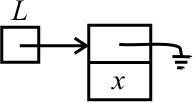
|
The list functions that we have written so far have been nondestructive, meaning that they do not alter a list. Now we turn to destructive algorithms, which do alter lists, either by changing the numbers in the list cells or by changing the list structure by altering the pointers.
Imagine that you have a linked list L that is in nondescending order. For example, list [2, 4, 4, 5, 9] is in nondescending order, but [2, 4, 3] is not. You would like to insert a value into that list, changing the list, and preserving the fact that it is in nondescending order. For example, if L is [2, 4, 4, 5, 9] before inserting 7, then L is [2, 4, 4, 5, 7, 9] after inserting 7.
When thinking about destructive functions, it is best to look at linked list diagrams rather than only looking at conceptual lists. Starting with linked list

and inserting 7 leads to the following linked list.

Notice that one list cell has been created to hold 7.
This function needs to be able to change the pointer in L so that it can insert a new cell, as can be seen from cases 1 and 2 below. So L needs to be passed by reference. There are three cases to consider to insert x into L.
If L is an empty list, just change L to [x] = cons(x, NULL).

If L is not empty and its head is greater than or equal to x, then x belongs at the beginning of the list; change L to cons(x,L). For example, if x is 1 and L is [2, 4, 6, 8], change L to be [1, 2, 4, 6, 8].

If L is not empty and its head is less than x then insert x into the tail of L. The change in pointers in the tail of L will affect L.
L = cons(x, L);since, in case 1, L is NULL. Coding those ideas in C++ yields the following definition of insert.
// Insert(x,L) inserts x into list L, changing L. // // L must be in nondescending order when insert is called, // and x is inserted in the correct place so that // L remains in nondescending order after the insertion. void insert(const int x, List& L) { if(L == NULL || x <= L->head) { L = cons(x, L); } else { insert(x, L->tail); } }Notice that the definition of insert is tail-recursive. An optimizing compiler can change it into a loop for you.
Suppose that line
insert(x, L->tail);
in the definition of insert is replaced by the
following line.
insert(x, tail(L));
That does not work. The problem is that the second parameter
of insert uses call-by-reference. That means the
actual thing that is passed must be a variable.
L->tail is a variable, but tail(L) is not.
Write a C++ definition of function removeAll(x, L), which removes all occurrences of x from list L, changing L. Answer
Write a C++ definition of destructive function addToEnd(x, L), which adds x to the end of list L. Answer
Write a C++ definition of destructive function addToStart(x, L) that adds x to the beginning of list L. If L has length n, how long does it take to perform addToStart(x, L)? Answer
Write a C++ definition of function destroy(L), which deletes every cell in list L. Answer
|